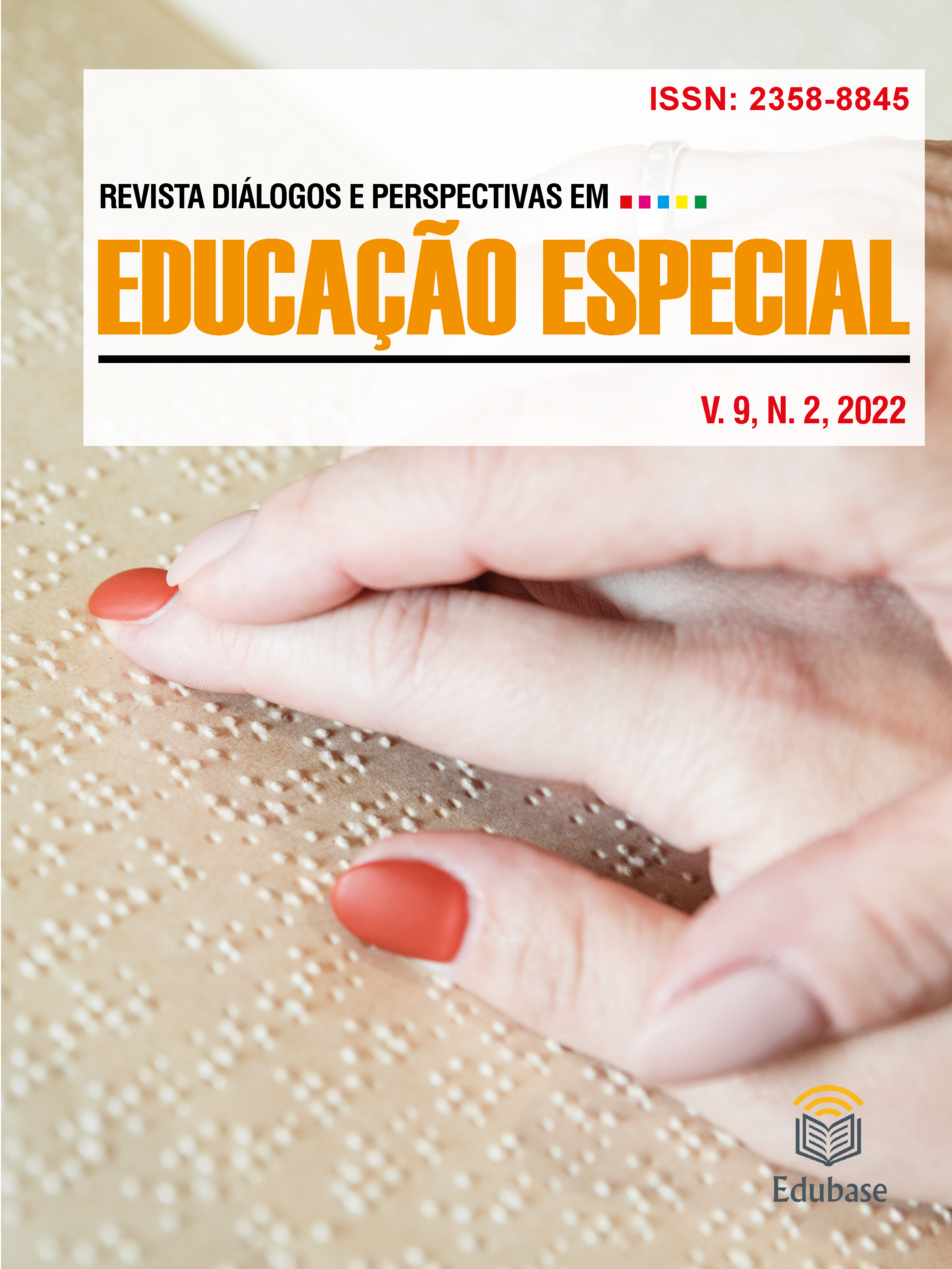LITERATURE REVIEW:
DEVELOPMENT OF TEACHING STRATEGIES FOR STUDENTS WITH VISUAL IMPAIRMENTS
DOI:
https://doi.org/10.36311/2358-8845.2022.v9n2.p113-126Keywords:
Teaching strategies, Visual Impairment, Physical education.Abstract
The development of teaching strategies for pedagogical practice with visually impaired students represents a great challenge for Physical Education teachers, especially considering the issues of accessibility and necessary adaptation to the classroom equipment. We aim to analyze the academic production from 2012 to 2022 on the development of teaching strategies for students with visual impairment in Physical Education classes. This is qualitative research that is characterized as a literature review study. Data collection took place in the ERIC, EBSCO, SportsDiscus, Scielo - Scientific Electronic Library Online, Lilacs and Scopus databases with the terms visual impairment AND physical education AND teaching strategies; visual impairment AND physical education AND teaching strategies with a period from 2012 to 2022. A total of 260 articles were found, of which 230 articles were excluded for not meeting the inclusion criteria, 10 articles were excluded due to duplicity, leaving 20 articles analyzed.
Downloads
References
BRIAN, Ali et al. The effects of ecologically valid intervention strategies on the locomotor skills of children with visual impairments. Adapted Physical Activity Quarterly, v. 37, n. 2, p. 177-192, 2020.
COLEMAN, Jeremy M. The use of music to promote purposeful movement in children with visual impairments. Journal of Visual Impairment & Blindness, v. 111, n. 1, p. 73-77, 2017.
DA CUNHA FURTADO, Otávio Luis Piva et al. Physical activity interventions for children and youth with visual impairments. Adapted Physical Activity Quarterly, v. 32, n. 2, p. 156-176, 2015.
FIORINI, Maria Luiza Salzani; DELIBERATO, Débora; MANZINI, Eduardo José. Estratégias de ensino para alunos deficientes visuais: a Proposta Curricular do Estado de São Paulo. Motriz: Revista de Educação Física, v. 19, p. 62-73, 2013.
HABULEZI, J.; PHASHA, T. N. Provision of learning support to learners with visual impairment in Botswana: A case study. Procedia-Social and Behavioral Sciences, v. 69, p. 1555-1561, 2012.
HAEGELE, Justin A.; LIEBERMAN, Lauren J. The current experiences of physical education teachers at schools for blind students in the United States. Journal of Visual Impairment & Blindness, v. 110, n. 5, p. 323-334, 2016.
HAEGELE, Justin A. Promoting leisure-time physical activity for students with visual impairments using generalization tactics. Journal of Visual Impairment & Blindness, v. 109, n. 4, p. 322-326, 2015.
HAEGELE, J. A. et al. Exploring the intersection between disability and overweightness in physical education among females with visual impairments, Research Quarterly for Exercise and Sport, 2019. https://doi.org/10.1080/02701367.2019.1600652
HASTIE, Peter A.; WARD, Jeffrey K.; BROCK, Sheri J. Effect of graded competition on student opportunities for participation and success rates during a season of Sport Education. Physical Education and Sport Pedagogy, v. 22, n. 3, p. 316-327, 2017.
KASAP, Caner; BAHÇALI, Turgut. An Investigation into Lecturers’ Perceptions and Experiences Regarding Students with Special Needs. Education Quarterly Reviews, v. 5, n. 1, 2022.
LE FANU, Guy; SCHMIDT, Elena; VIRENDRAKUMAR, Bhavisha. Inclusive education for children with visual impairments in sub-Saharan Africa: Realising the promise of the Convention on the Rights of Persons with Disabilities. International Journal of Educational Development, v. 91, p. 102574, 2022.
LIEBERMAN, Lauren J. et al. How students with visual impairments can learn components of the expanded core curriculum through physical education. Journal of Visual Impairment & Blindness, v. 108, n. 3, p. 239-248, 2014.
LIEBERMAN, Lauren J. et al. Physical education for children with visual impairment or blindness. Journal of Physical Education, Recreation & Dance, v. 90, n. 1, p. 30-38, 2019.
LIEBERMAN, Lauren J.; CONROY, Paula. Training of paraeducators for physical education for children with visual impairments. Journal of Visual Impairment & Blindness, v. 107, n. 1, p. 17-28, 2013.
MIYAUCHI, Hisae. A systematic review on inclusive education of students with visual impairment. Education sciences, v. 10, n. 11, p. 346, 2020.
MCLINDEN, Michael. Mediating haptic exploratory strategies in children who have visual impairment and intellectual disabilities. Journal of Intellectual Disability Research, v. 56, n. 2, p. 129-139, 2012.
MOWLING, Claire M.; FITTIPALDI-WERT, Jeanine; FAVORETTO, Loraine. Soundball: Teaching Tennis to Students with Visual Impairments. Strategies, v. 30, n. 4, p. 3-10, 2017.
RALEJOE, Malehlanye. A study to understand the inclusion of learners with and without visual impairment in a secondary school in Lesotho. South African Journal of Education, v. 41, n. 1, p. 1-12, 2021.
REINA, R. et al. Incluye-T: a professional development program to increase the self-efficacy of physical educators towards inclusion. Physical Education and Sport Pedagogy, v. 24, n. 4, p. 319-331, 2019.
STRIBING, Alex et al. Teaching Strategies to Improve Object Control Development for Children with Visual Impairments in Physical Education. Palaestra, v. 33, n. 1, 2019.
STROGILOS, Vasilis; STEFANIDIS, Abraham. Contextual antecedents of co-teaching efficacy: Their influence on students with disabilities' learning progress, social participation and behaviour improvement. Teaching and Teacher Education, v. 47, p. 218-229, 2015.
WHINNERY, Stacie B.; WHINNERY, Keith W.; EDDINS, Daisy. A Strategy for Embedding Functional Motor and Early Numeracy Skill Instruction into Physical Education Activities. Physical Disabilities: Education and Related Services, v. 35, n. 1, p. 17-27, 2016.
Downloads
Published
Issue
Section
License
Copyright (c) 2022 Revista Diálogos e Perspectivas em Educação Especial

This work is licensed under a Creative Commons Attribution 4.0 International License.
- The works published in RDPEE are the sole responsibility of their authors. The authors grant the journal the right of first publication, with the work simultaneously licensed under the Attribution-CC BY, which allows distribution, remixing, adaptation and creation from the work with recognition of the authorship and initial publication in this journal.
- The authors consent that their articles may be incorporated by RDPEE into indexers and databases that currently exist or may exist in the future; the owners of these databases may reproduce, transmit and distribute the texts, in whole or in part, in any form or means of electronic transmission that exists or may be developed in the future.
Qualis Capes (2017-2020)
Education: B1




